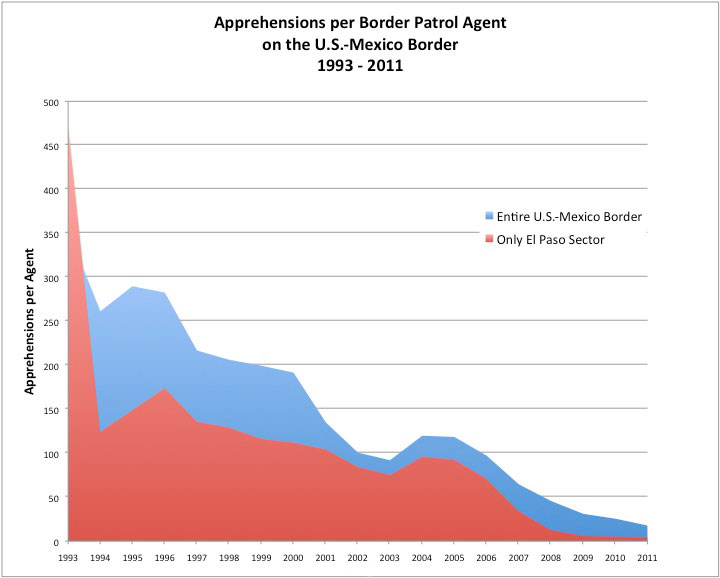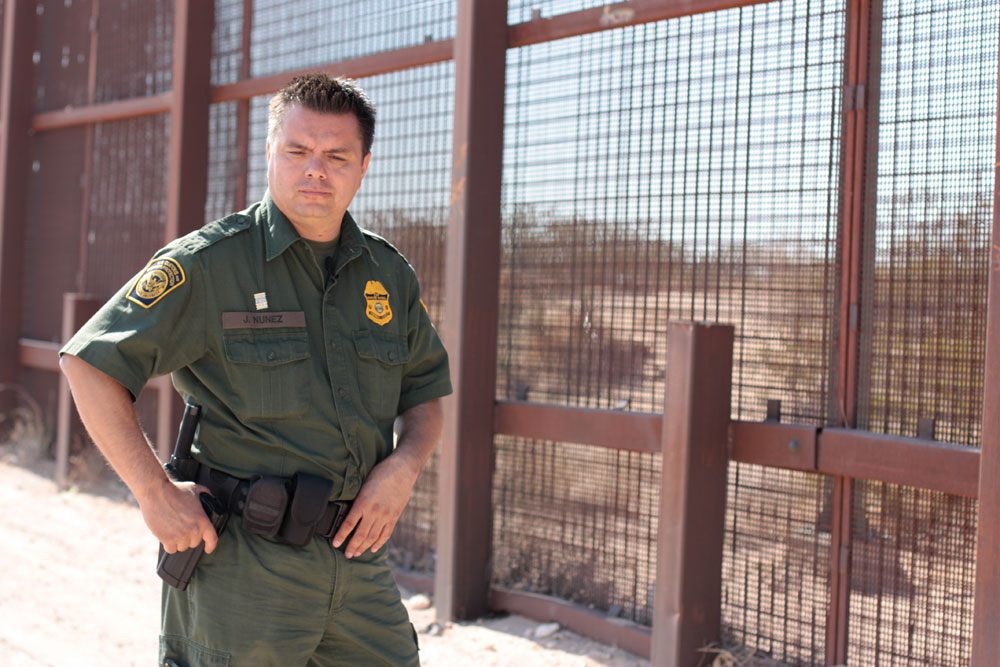Results 1 to 1 of 1
Thread Information
Users Browsing this Thread
There are currently 1 users browsing this thread. (0 members and 1 guests)
-
05-24-2012, 01:57 PM #1
New policy could change role of U.S. Border Patrol agents
New policy could change role of U.S. Border Patrol agents
By Mariana Dale, Richard Schaefer, Carolina Cruz and Holly Ocasio Rizzo on May 24, 2012
EL PASO – Border Patrol agents might soon switch from sitting in trucks along the U.S.-Mexico border to helping traffic move more efficiently on the international bridges.
This scenario comes from the idea of Border Patrol agents collaborating with other government agencies and institutions.
Border Patrol Chief Michael Fisher in May announced a strategy plan to fight transnational crimes and drugs, support Homeland Security efforts and aid U.S. Customs and Border Protection.
 A sign marks an area restricted by the U.S. Border Patrol near the line between Juarez and El Paso. (Mariana Dell/Borderzine.com)
A sign marks an area restricted by the U.S. Border Patrol near the line between Juarez and El Paso. (Mariana Dell/Borderzine.com)
One possible outcome might be reassigning Border Patrol agents to Customs border crossings to reduce the long wait.
“Currently Customs and Border Protection needs all of the staffing help that they can get – in particular at our ports of entry,” said El Paso City Representative, Steve Ortega, through an email statement.
As Border Patrol agents apprehend fewer undocumented people each year, its mission as an agency with resources focused on deterring and apprehending undocumented crossers is being reconsidered.
Currently, Immigration and Customs Enforcement (ICE) personnel in the El Paso area of responsibility are apprehending and removing more undocumented people through the Secure Communities Program, employment raids and by catching crossers at major ports of entry than the Border Patrol, according to Border Patrol and ICE enforcement and removal figures.
That is why the Border Patrol 2012-2016 Strategic Plan calls for redirecting its agents’ efforts toward relieving congestion and waits at the ports of entry, as well as combating terrorism and transnational crime.

In light of a dramatic decrease in apprehensions of undocumented crossers, a recently issued Border Patrol 2012-2016 Strategic Plan calls for redirecting its agents’ efforts toward relieving congestion and waits at the ports of entry, as well as combating terrorism and transnational crime. By the close of FY 2011, the typical Border Patrol agent working from Texas to California was apprehending 17.7 undocumented people a year, from a high of 352.2 per agent in 1993.
In comparison, the numbers fell even more for agents in the El Paso Sector, from a high of 470 apprehensions per agent in 1993 to only 3.8 apprehensions by 2011.(Richard Schaefer/Borderzine.com)
By the close of fiscal year 2011, the typical Border Patrol agent working from Texas to California was apprehending 17.7 undocumented people a year, from a high of 352.2 “illegal alien apprehensions” per agent in 1993. In comparison, the numbers fell even more for agents in the El Paso Sector, from a high of 470 apprehensions per agent in 1993 to only 3.8 apprehensions by 2011.
More agents at entry checkpoints would be a relief for some people of El Paso.
“People would cross to go to work, or to go to restaurants and enjoy the nightlife. They would cross to see family and they would cross to engage in trade. It used to be pretty easy to cross and it’s gotten more and more difficult,” said border journalist Louie Gilot.
Gilot is the publisher of Newspaper Tree, a non-profit online news organization in El Paso. Previously, she covered immigration issues as a reporter for the El Paso Times.
For those who cross the border back and forth as part of their daily lives, long waits are too time consuming.
“There used to be no lines when you were going on foot and now there is. I have spent an hour on foot,” Gilot said.
Gilot also mentioned that a friend recently spent three hours on the international bridge in her car waiting to come back into the United States.
Other residents of El Paso think if U.S. Customs and Border Protection needs more help to move traffic faster at busy border crossing points, it should come up with another solution.
“I think Border Patrol should be left alone to do their jobs on the side and let the Customs hire more people,” said David Faulkner, recreation specialist at El Paso Chihuahuita Recreation Center.
Changes in numbers and technology
 Border Patrol Agent, Jacob Nuñez, walks along a standard pedestrian fence in New Mexico. The fence is an example of a collaboration between the Border Patrol and local landowners. (Mariana Dell/Borderzine.com)
Border Patrol Agent, Jacob Nuñez, walks along a standard pedestrian fence in New Mexico. The fence is an example of a collaboration between the Border Patrol and local landowners. (Mariana Dell/Borderzine.com)
With the implementation of Operation Hold the Line in El Paso in 1993, the Border Patrol strategically deployed resources to meet the highest priority threats.
There has been a 53 percent decrease in apprehensions of undocumented border crossers since 2008, according to Fisher’s testimony at a hearing of the Homeland Subcommittee in Washington.
One of the aspects of the new strategy plan is for the Border Patrol to improve the use of new equipment to keep those numbers down.
“Technology is a very big part of what we do here,” said Jacob Nuñez, Border Patrol agent. Once Border Patrol agents just used flashlights, they now have powerful binoculars with night vision, remote video surveillance systems and even truck roof cameras that work on hydraulics to rise up and scan the area.
Agents in the neighborhood
In Chihuahuita, one of the El Paso neighborhoods a stone’s throw away from Ciudad Juarez, violence and safety is not a concern for some residents since an 18-foot wall was built between the U.S. and Juarez in 1993. Border patrol agents no longer are commonly seen chasing illegal crossers through the streets.
“We go to sleep at ease here thanking God when we go to sleep and back again when we wake up… I am very happy living here,” said Concepcion Concha Flores, a resident of Chihuahuita for 10 years.
Border Patrol agents host community events with the residents of Chihuahuita. An example is the annual Christmas party at the El Paso Chihuahuita Recreation Center in the heart of the neighborhood.
“The border patrol workers give the donation and presents and all that, and we have someone who does Santa Claus and we have food for them that day also,” Faulkner said.
Fisher expects the Border Patrol strategy plan to be completed in 2013.
_____
New policy could change role of U.S. Border Patrol agents | BorderzineRelated information: United States Border Patrol Statistics
NO AMNESTY
Don't reward the criminal actions of millions of illegal aliens by giving them citizenship.
Sign in and post comments here.
Please support our fight against illegal immigration by joining ALIPAC's email alerts here https://eepurl.com/cktGTn


 LinkBack URL
LinkBack URL About LinkBacks
About LinkBacks




 Reply With Quote
Reply With Quote


New poll shows rising Latino support for border wall, mass...
04-18-2024, 06:50 PM in General Discussion